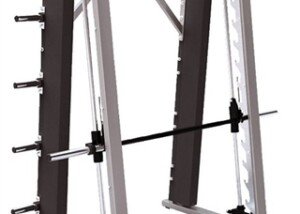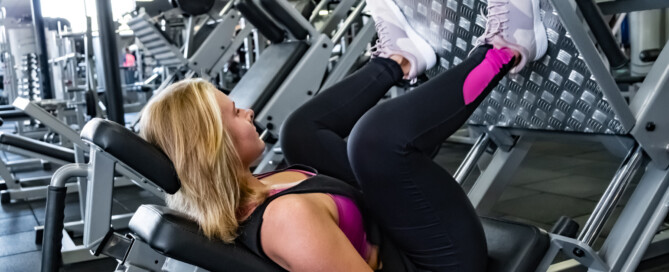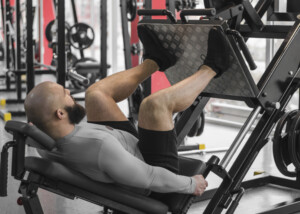100 Pullups in a Row: Muscle Builder or just a Show-Off Move?

Is there really a purpose in doing 100 pullups in a row other than to show off or train for the CrossFit Games?
Does someone who can do 100 pullups look better than someone who can do “only” 50? (more…)
Killer Shoulder Workout with the Smith Machine

The Smith machine can be used for a blistering shoulder workout; it’s not just for squats.
Here is a unique workout with just one exercise using the Smith machine. (more…)
Leg Exercise Burns Tons of Fat: Leg Press Machine How-To

If you want to burn the fat off your thighs, forget the inner-outer machine and do LEG PRESSES.
The leg press machine, when used a certain way, will melt fat right off your legs.
Don’t go through mere motions.
Very often I’ll see overweight women using the horizontal or floor leg press equipment – but just going through the motions.
The resistance is set so light that they’re able to rock the sled back and forth with little effort.
Or, if it’s a heavier load, the range of motion is set small.
Need I say that I never see these exercisers showing any kind of strain. Now don’t think that “strain” is a bad thing.
There’s nothing wrong with straining when you don’t have a medical condition in which straining could cause a problem, such as uncontrolled high blood pressure.
It’s also important to note that men, too, are capable of going through motions on the leg press apparatus.
But oddly, this scene almost always involves women. Perhaps they believe that making the exercise harder will bulk up their legs with chunks of muscle.
Don’t believe this for a second! This device can be used as a fat burner that shrinks big thighs.
Another trend is that personal trainers don’t gravitate towards this simple piece of equipment for their clients who want to burn fat.
Instead, many trainers these days have their clients (of varying fitness levels) standing on one foot and curling dumbbells, or doing some other gimmicky movement.
Leg Press Workouts Burn Fat Better than the Inner Outer Machines
The leg press is old, simple, basic and very effective. It’s time to bring it back to the forefront for women seeking fat loss, fitness and better looking legs.
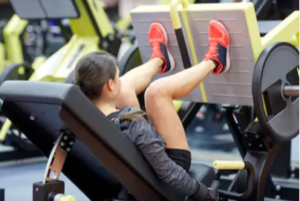
Shutterstock/Syda Productions
The best equipment that works best for blasting fat is the floor version, also referred to as the 45-degree version.
The seat is on the floor, and the trainee’s back is inclined back, close to the floor (the angle can be adjusted). With this version, you are pushing upward against resistance, rather than horizontally.
Even the most out of shape person can do this exercise. If you don’t think you can independently enter into the apparatus or independently exit it, give it a try and you’ll be surprised at your abilities.
Don’t avoid this fat burning equipment. Once you’re settled in, you can press the sled, even if you’re weak, obese and totally out of shape.
The seat stabilizes the lower back, so even those with “bad backs” may find this equipment quite doable.
Best Way to Use Leg Press Machine to Burn Fat in the Thighs

Freepik.com, halayalex
• Lower the sled as close to your chest as possible.
• If your stomach gets in the way of this, place your feet further apart so that your knees clear your midsection.
• Do not let the knees cave in or buckle towards each other, especially when pressing the sled back up to the start position.
• Start out with light weights if you’re new to this machine.
• Do not lock your knees out at the top of the movement; keep a slight bend.
• After several weeks of getting used to the exercise with light weights, increase the weights.
• The goal is to set the weight heavy enough such that it’s absolutely impossible to do more than 12 repetitions, but you can do at least eight.
• Take about a minute in between each set.
• Include sets where the start position is with your legs fairly bent. This technique is called partial reps. Bring the sled down deep, then push back up but STOP at this lower position.
• Do six to eight sets total. Your legs should feel fried at the end of the routine.
For best results with the leg press to burn fat off your legs, use this machine no more than twice a week.
Once a week is actually sufficient to cause fat loss.
And remember, if the routine isn’t very challenging, you won’t get good results.
 Lorra Garrick is a former personal trainer certified through the American Council on Exercise. At Bally Total Fitness she trained women and men of all ages for fat loss, muscle building, fitness and improved health.
Lorra Garrick is a former personal trainer certified through the American Council on Exercise. At Bally Total Fitness she trained women and men of all ages for fat loss, muscle building, fitness and improved health.
.
Top image: Shutterstock/Aleksey Boyko
Why Fat Camps for Children & Teens Fail; Solutions

Think long and hard before sending your obese child to that luxurious “fat camp” tucked away in the majestic mountains somewhere. (more…)
Best Way an Overweight Teen Girl Can Lose Weight

The best weight loss plan for teen girls starts with accepting the fact that skipping meals will sabotage your weight loss efforts.
Going long periods without food, especially when you’ve been exercising, will most likely slow down your metabolism.
There are exceptions, but for many teenage girls, this will be the result.
And this will make losing weight difficult.
When teen girls go long periods without food, this teaches their body to STORE fat, rather than burn fat and lose pounds.
This is because your body, being deprived of food for long stretches of time, won’t “know” when the next meal or snack is.
The body then becomes better at holding onto stored fat, and storing even more fat from food when it finally comes.
Teen girls often skip breakfast, and if they eat anything at lunch, it’s often a few bites of something, or maybe a soda and potato chips.
For teen girls trying to lose weight, a chicken salad sandwich on whole wheat bread, and fruit juice or skim milk, will be far more satisfying, and contribute to your weight loss plan.
I’m assuming that if you’re a teen girl reading this article, you are overweight, even if by 10 pounds.
Some teen girls are obsessed with losing weight, even though they are already on the thin side.
If you’re a teen girl on the heavy side, keep reading.
You must eat breakfast, lunch, dinner, and somewhere along the way, a snack or two in between meals.
Focus on fruit, natural fruit juices, vegetables, whole grains, chicken, fish and beans, and go light on beef.
Try to enjoy beef and potatoes without the gravy, which is 100 calories per tablespoon.
Exercise BEFORE you eat, not after. Exercising before you eat will make your body more efficiently utilize calories from the after-workout meal.
It’s perfectly okay for teen girls to lift weights. Teen girls will not injure themselves if they use proper form and start with light weights.
In fact, lifting weights causes far fewer injuries to teen girls, percentage-wise, than other physical activities that are more common for teen girls, such as soccer, lacrosse, basketball and running.

Chest Press. Shutterstock/Travelerpix
Lifting weights will fuel weight loss, shape and tone your body, and that includes toning the stomach and slimming the waist.

Leg Press. Shutterstock/Aleksey Boyko
Adding lean muscle will raise resting metabolism. For weight loss, please do not take up smoking.
If a teen girl starts smoking in the name of losing weight, you will one day be saddled with the ongoing struggle of trying to quit this stinky, expensive, harmful habit.
Look around you at a crowded outdoor area; you’ll see plenty of fat women smoking.
A teen girl might lose a little weight from smoking, but she’ll eventually gain that weight back, and even more, as she gets older and increasingly tired from lack of exercise and lack of lung power.
If you want to put something long and slender in your mouth, make it a carrot or celery stick.
Teen girls should include cardio exercise for their weight loss plan, several times a week. 20 minutes of vigorous cycling, walking, stepping, dancing, swimming, kicking, or use of a cardio machine all count as effective exercise.
Finally, skip the diet pills. These are drugs that will not teach your body to become naturally efficient at burning up fat.
Lastly, if you’re a teenage girl struggling to lose weight, don’t take laxatives and don’t take diet pills. Stay natural, stay clean, stay healthy.
 Lorra Garrick is a former personal trainer certified through the American Council on Exercise. At Bally Total Fitness she trained women and men of all ages for fat loss, muscle building, fitness and improved health.
Lorra Garrick is a former personal trainer certified through the American Council on Exercise. At Bally Total Fitness she trained women and men of all ages for fat loss, muscle building, fitness and improved health.
Workouts for Six-Pack Abs: You’ll Be Surprised what Works Best

Some men who have a six pack just happen to have one, but it seems that women must work harder to get six pack abs. (more…)
Cardio Exercise vs. Diet for Ripped Abs?

If you want hot abs, you might be wondering if diet might be better than cardio, or the other way around:
Perhaps cardio wins over diet when it comes to getting great abs.
To understand which is better for getting ripped abs — cardio or diet — ask yourself this question: Which is better for getting buff arms: cardio or diet?
Which is better for getting sculpted legs: cardio or diet?
Cardio beats diet when it comes to getting ripped abs. Cardio beats diet also when it comes to shaping the arms and legs ‘” though when compared to lifting weights for shaping arms and legs, cardio is inferior.
A person with a gleaming six-pack of abs works out. Almost always, he or she “watches his diet,” but all the diet does is help remove a lot of the fat between the skin and abdominal muscle, so that the abs are more visible.
But if those ab muscles are not trained, and instead are flabby and weak, they won’t show much, if at all, even if you don’t have much fat in that area.
A thin person who does not exercise, or whose exercise regimen is lame, never has a six-pack.
At the most, they have a subtle “arch” in their abs: the outline of where the six-pack is supposed to be — and it is hardly noticeable.
A person who diets and loses weight, but does not exercise, will not have shapely or defined shoulders and arms, either.
In order for muscles to show, including abdominal muscles, they must be exercised.
Cardio can be one great way to condition your abs and get them showing (assuming your body fat percentage is low enough).
Look at Olympic sprinters. They have amazing six-packs. Same with 400-meter specialists.
Even the 800-meter specialists often show six-pack abs, though the shorter the distance that the athlete specializes in, the more prominent the ab muscles tend to be.
This is because 1) High speed running recruits core muscles more than slower speed running, and 2) The training that sprint athletes endure is conducive to high amounts of fat-burning.
Have you ever seen a “really skinny” woman who actually had a puffy waistline and absolutely no abdominal definition? She either doesn’t exercise, or does only mild levels of exercise.
A skinny man, too, may be absent the signs of abdominal definition, especially if he is older.
For ripped abs, don’t overeat. Whittle down the body fat with weight workouts and cardio exercise, preferably high intensity interval training.
Focus on large muscle groups for melting off fat when it comes to weight workouts.
Higher Energy Expenditure: Exercises that target large muscle groups, such as squats, deadlifts, and bench presses, require more energy and burn more calories compared to those targeting smaller muscles. This increased calorie burn helps in fat loss.
Increased Metabolic Rate: Working large muscle groups can elevate your metabolism not just during the workout but also for hours afterward, known as the afterburn effect or excess post-exercise oxygen consumption (EPOC).
Hormonal Response: Engaging large muscle groups stimulates the release of hormones like testosterone and growth hormone, which aid in fat loss and muscle growth.
 Lorra Garrick is a former personal trainer certified through the American Council on Exercise. At Bally Total Fitness she trained women and men of all ages for fat loss, muscle building, fitness and improved health.
Lorra Garrick is a former personal trainer certified through the American Council on Exercise. At Bally Total Fitness she trained women and men of all ages for fat loss, muscle building, fitness and improved health.
.
Top image: Shutterstock/FXQuadro
How Men & Women over 45 Can Get a Six-Pack

You can get a six-pack even if you’re over 45 and have never had one.
But first, here’s what you should NOT do in your quest for a six-pack — these will only waste your time:
-Crunches
-Sit-ups
-Side bends
-Twists
In order for your six-pack to show, your overall body fat percentage must be in the lean range (the leaner you are, the more it will show), and when I say “lean,” I don’t mean skinny like a marathon runner or runway model.
A man can be 5-9, weigh 190 pounds and still be very lean.
A combination of smart eating habits and specific exercises, as well as specific exercise intensity, will help the man or woman over age 45 achieve a six-pack.
The following exercises will help you achieve the abs you dream of:
Deadlift
Squat
Pushup
Chin-up/Pull-up
Sprint intervals
Let’s take this a little further:
Sled push
Tire flip
Hill dash and other forms of high intensity interval training, which can be done with a jump rope, a box or stool for jumping, or even a stationary bike.

Deadlift. Shutterstock/Maridav

Pull-up

Pushup. Freepik.com Racool_studio
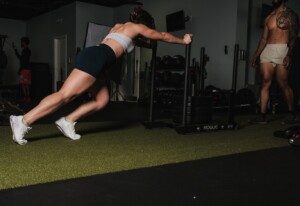
Sled push. Pexels-airam-datoon

Squat. Freepik
These aforementioned exercises, when done intensely with whatever weight or level feels strenuous and heavy to you, will slash body fat and tone and harden your six-pack region.
Forget crunching, folding up your body and twisting it. People over 45 who can’t figure out why they can’t “get” a six-pack are, no doubt, not focusing on the deadlift, pushup and chin-up or pull-up, for example.
These three exercises actually hit the abs hard. When you see someone doing a sagging pushup, with their midsection drooping rather than their body straight, this isn’t necessarily because their arms are weak.
It’s because their abs (which comprise the core) are weak.
Let’s throw in another great exercise for the abs: dumbbell pushup row.
Work on your deadlifts, squats, pushups and chin-ups — just those alone — plus controlled eating — and you will begin seeing a six-pack, even if you’re over age 45.
The compound strength training moves listed here recruit abdominal muscle; they work the entire core.
When you develop the strength to do chin-ups, you’ll know exactly what I mean.
Ask anyone who can do chin-ups or pull-ups for reps if they can “feel” their abs while doing the reps, particularly on the way down from each rep. Listen to their response.
 Lorra Garrick is a former personal trainer certified through the American Council on Exercise. At Bally Total Fitness she trained women and men of all ages for fat loss, muscle building, fitness and improved health.
Lorra Garrick is a former personal trainer certified through the American Council on Exercise. At Bally Total Fitness she trained women and men of all ages for fat loss, muscle building, fitness and improved health.
.
Top image: Shutterstock/Jules43
Could Carrie Fisher Have Prevented Her Heart Attack?
There are steps Carrie Fisher could have taken, other than healthy diet & exercise, that may have prevented the heart attack she suffered on an airplane.
Drugs, alcohol, smoking and crash dieting have been blamed on Carrie Fisher’s heart attack on an airplane.
I was inspired to write this article after reading specific types of comments to news reports about Carrie Fisher’s heart attack.
It goes like this: Someone comments that Carrie Fisher’s poor diet and use of substances caused the heart attack.
Then a slew of opposing comments follow, to the tune of:
• Anyone can get a heart attack.
• A heart attack can strike a healthy, jogging vegetarian.
• Genetics plays a large role; not much you can do to prevent it.
• When your number is up, it’s up.
• Eat healthy and exercise, then die anyways.
• My uncle (or father, husband, wife, sister) ran five miles a day, played tennis and never smoked a single cigarette or had so much as a sip of beer, then had a heart attack at age 48. Not much you can do.
None of these comments mention the prevention of heart attack via heart disease screening tools.
Every woman gets an automatic risk factor for a heart attack on her 50th birthday–depending on which medical institution or cardiologist you speak to. But mayoclinic.com puts the marker at 55 for women.
All women, once they turn 50, should undergo heart disease screening!
A person who is hooked on painkillers, cocaine, smoking and drinking, and who doesn’t embrace a workout regimen, probably isn’t going to care too much about routine heart disease screening.
- Coronary calcium score test
- Cholesterol test
- Stress test
- Annual visits to a cardiologist
Unless they have chest pain and difficulty breathing—and even then, many people let these symptoms go, figuring they’re caused by stress or normal aging.
We don’t know if Carrie Fisher had been having symptoms in the weeks or months leading up to her heart attack and kept quiet about them.
But could she have prevented the heart attack with heart disease screening beginning at age 50?
And nobody says that screening for women must begin at 50; a 35-year-old woman is just as welcome to visit a cardiologist to see if everything seems okay.
She can request an echo stress test; this measures blood flow through the heart during exercise.
And an echocardiogram measures heart function and structure.
The calcium score test involves the CT scanner.
The calcium score test shows the extent of hard or calcified plaque in the coronary arteries. When this stable plaque is present, its amount is correlated to a number: the calcium score.
Calcium scores strongly correlate to the presence of SOFT (unstable) plaque. Soft plaque is the type that can rupture, causing a heart attack.
High “bad” cholesterol and triglyceride levels are associated with high heart attack risk, though heart attacks also occur in people with normal cholesterol.
That’s because there are other pathways to a heart attack other than clogged arteries, such as atrial fibrillation, a heart rhythm disorder. This can cause blood to pool in the heart, leading to clots—causing a heart attack.
It really is fair to wonder if Carrie Fisher’s heart attack could have been prevented had she begun getting annual screening for cardiac problems even five years prior to her death.
• What would the various tests, including an EKG, have picked up?
• What would her calcium score have been?
• What would her cardiologist, had she seen one, recommended, based on those test results?
• Maybe she would have been placed on simple aspirin therapy.
• Maybe she would have been advised to have a catheter angiogram if her test results were very concerning (especially if she was having suspicious symptoms—which we still don’t know if she had or not) which then would have revealed a blockage that could have been corrected with a stent–or bypass surgery.
• Even just one test result—the calcium score, if suggestive of heart disease—can frighten a person into taking immediate and aggressive measures to halt its progression and prevent a heart attack.
• Maybe high blood pressure contributed to the airplane event—and high blood pressure can usually be well-controlled with medication and diet.
So whether you think that heart attacks strike people randomly, regardless of their lifestyle habits, or are largely determined by genetics or Martians, this does NOT take away from the fact that cardiac-problem screening can go a tremendously long way in preventing heart attacks!
Even people with healthy lifestyle choices should get screened for heart disease.
 Lorra Garrick has been covering medical, fitness and cybersecurity topics for many years, having written thousands of articles for print magazines and websites, including as a ghostwriter. She’s also a former ACE-certified personal trainer.
Lorra Garrick has been covering medical, fitness and cybersecurity topics for many years, having written thousands of articles for print magazines and websites, including as a ghostwriter. She’s also a former ACE-certified personal trainer.
.
Top image: Shutterstock/ Robert Kneschke
Source: mayoclinic.org/diseases-conditions/heart-attack/basics/risk-factors/con-20019520
Which Burns More Fat: Running or Incline Walking?






